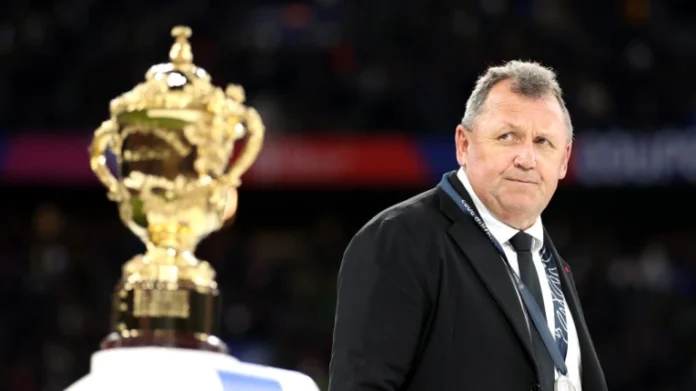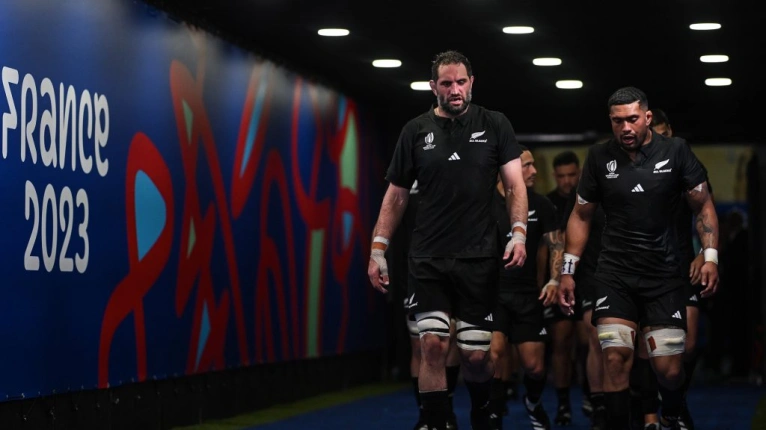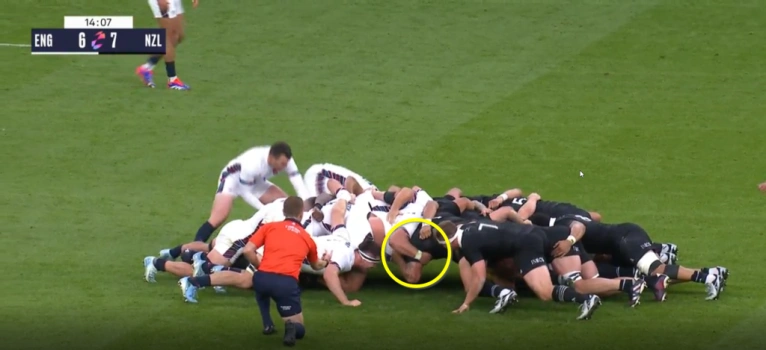
[ad_1]
Ask any rugby league aficionado who is the greatest league coach in professional history, and they are more than likely to give you the same answer: Craig Bellamy. Supporters of Jack Gibson and Wayne Bennett might split hairs, but it is extraordinarily hard to argue with Melbourne Storm supremo Bellamy’s record over three decades in one of the most competitive leagues in the world: 21 finals appearances in 22 seasons, nine grand finals with five victories.
Now a dose of perspective: in his tenure as head coach of the All Blacks, Ian Foster achieved 32 wins from 46 matches at a 69.6% win rate – the same as Bellamy, and fractionally ahead of double World Cup winner Rassie Erasmus, who currently stands at 69.4%. But while Erasmus is elevated to demigod status in his country, and the man nicknamed ‘Bellyache’ is considered a legend of his sport, ‘Fozzy’ is largely perceived as a failure.
Ian Foster is not widely regarded as a successful All Blacks coach, despite reaching the World Cup final last year (Photo by Michael Steele – World Rugby/World Rugby via Getty Images)
He lost the 2023 World Cup final by a single point to Rassie’s Springboks after playing the bulk of the game with only 14 men, but on such fine margins do sporting reputations turn. Foster’s part in the reconstruction job after the disastrous series defeat by Ireland in 2022 was consigned to the dustbin of history, and the support he gave to Sir Steve Hansen from 2012 to 2019 became a dim and distant memory.
That short sample amply describes the stratospherically high level of expectation that besieges all coaches of the All Blacks, granting them only the thinnest of air to breathe. Foster’s predecessors, two of the three wise men Sir Graham Henry and Hansen, guided their charges to consecutive World Cups, 11 Rugby Championships out of a possible 14, and colossal cumulative record of 191 victories from 210 Tests over 14 years, at an 86.2% win rate.
Nobody can live on the summit of Everest forever, and every ascent has a descent on the other side of the mountain. But what part did New Zealand rugby play in its own relative downfall? How and when did New Zealand [and their supporters] begin to view themselves less as All Blacks, and more as Also-Rans?
New Zealand all-time great Sam Whitelock gave a most revealing insight into the personality differences between the three main men in his autobiography View from the Second Row:
 Sam Whitelock, pictured with Ardie Savea, is a totem of New Zealand rugby (Photo by David Ramos – World Rugby/World Rugby via Getty Images)
Sam Whitelock, pictured with Ardie Savea, is a totem of New Zealand rugby (Photo by David Ramos – World Rugby/World Rugby via Getty Images)
“I played under three All Blacks head coaches, and they were all, to some extent, products of their upbringing and vocations. Graham Henry was a former school principal who watched over everything with a helicopter view and a discerning eye. Steve Hansen was a former cop, always needing to know everything that was happening in the background. And Fozzie, a clergyman’s son, was a very caring, empathetic guy who believed in fairness.”
Reading between the lines, it was a case of two very active personalities being replaced by a more passive character:
“Like a good headmaster, ‘Ted’ let me know when I’d done something wrong, but he wasn’t micro-managing every aspect of my rugby education. ‘Shag’ was a cop, keeping a close eye on everything like a detective. He had no trouble looking a player in the eye and giving him a blunt and brutal gee-up.”
Move from there to empathy and a passive make-up and it was probably too big a leap for most of Henry and Hansen’s ex-players to make. It was something of nothing, a coaching afterthought.
Whitelock saw the writing on the wall as early as 2021, after twin tour defeats by Ireland and France: “We were not being coached well enough… we had prepared too many excuses for our under-performance.” A harder edge returned with the mid-2022 appointments of Joe Schmidt and Jase Ryan, but it was not quite enough to put the All Blacks over the top at the World Cup one year later.
New Zealand Rugby gave out word to Scott ‘Razor’ Robertson he could begin planning for the post-Fozzy era around the same time Ryan and Schmidt replaced Brad Mooar and John Plumtree in the coaching group, and the personality transplant at head coach began well before its official announcement.
It led to some uncomfortable clashes, most notably when Robertson and Foster publicly disagreed over the policy of national eligibility. Razor was open to moving on and picking players from overseas, Fozzy wanted to stay put and do what had worked for New Zealand rugby in the past. That focused the friction between a proactive, ‘get-up-and-go’ personality and the more circumspect, conservative view in a nutshell.
It is already too late now, to expect the introduction of a super proactive character to have the same impact as a Henry or Hansen. The genie is already out of the bottle and any revisit to the heady heights of their era is unlikely. The days of 70% are here to stay.
New Zealand’s last-gasp 24-22 win over England on Saturday – the All Blacks’ third win over the men in white in the Robertson era – moved Razor on to 72.7%. Assuming New Zealand beat Italy in their last tour game, it could be as high as 78.5%, or as low as 64.3% by the end of his first year in charge. Thus, 70% may become the new 85% for the All Blacks.
The new norm has expressed itself via inconsistency. Some departments of the team improved, others trod water or slid backwards in West London on Saturday afternoon. Although Beauden Barrett and Will Jordan created an excellent switch try between them in the 28th minute, the game management balance was still off, with Barrett kicking 16 times compared to twice only by Jordan.
Barrett is out injured for the next match against Ireland, so Razor will cycle back to Damian McKenzie and Jordan for that game. With both featuring in the All Blacks’ preferred backfield for counterattacking purposes and the new refereeing guidelines discouraging escorts of the receiver in place, it will present the men in green with some ripe targets for aerial bombardment.
On the positive side of the slate, Wallace Sititi enjoyed another outstanding man-of-the-match outing at six, Mark Tele’a returned to his rightful spot on the right rather than the left wing with major impact, and the bench front-row reversed the refereeing momentum at scrum time at a crucial point of the game.
The differences between right and left wing are often subtle but usually unappreciated. It is not uncommon to find wingmen who find the switch between edges uncomfortable: the receiving and fending hands are different, the main stepping foot changes and the positional requirements on defence, with the defender looking in from left to right, rather in the other direction, can be disorienting.
Tele’a is one of those who is far more at home on the right. He completed all of his tackles, scored two tries and recovered three contestable kicks in the air.
With the kicking lanes far more open for the chaser under the new guidelines, the game in Dublin could well be decided in the air, and Tele’a and Caleb Clarke are a strong combination in that area of the game.
It was the Aucklander’s second try which illustrated just how fine his feeling for space and time is out on the right sideline.
If Tamaiti Williams starts the climactic game in Dublin on the loosehead, the redoubtable Irish and Lions’ ‘jukebox’ Tadhg Furlong [“the hits just keep coming”] will be licking his lips. Where Bath’s Will Stuart had to defend against Ethan De Groot in July, he went on the attack against the young Crusader prop.

Williams habitually packs with a very low left elbow and Stuart constricts his space further with a strong right ‘farmer’s arm’ bind. At 6ft 5ins tall, there is nowhere for the young loosehead to go but down, and he conceded two penalties for his pains.
The introduction of Pasilio Tosi and Ofa Tu’ungafasi on one side, and Fin Baxter and Dan Cole on the other, changed the complexion of the scrummaging completely, with the All Blacks winning two penalties of their own and squeezing England hard enough to prevent an easy drop-goal attempt at the decisive moment of the match.
Most nations in the rugby world would accept a 70% win rate without the slightest hesitation. Some Tier One teams would bite your hand off if such an offer was presented. Not so the All Blacks and their supporters, who have been fed a rich diet of 85%-plus far too long for their good.
The succession planning from the supremely innovative, proactive days of the three wise men – Henry, Hansen and ‘the Professor’ Sir Wayne Smith – suddenly became merely a conservation project under the nurturing hand of Foster. Fozzy was more suited to rearranging the products of the past than staying ahead of the game, and the rest of planet rugby grabbed the opportunity to catch up with New Zealand gleefully.
By the time Robertson took over the reins it was already too late, and the die was cast. New Zealand may be doomed to the 70% flatline for the foreseeable future, and Robertson will be repeating the same tired record for some time to come:
“I don’t think George Ford has ever missed a drop kick in his life, you know. We showed a lot of character, stayed in the fight for a long period of time and [with] 15 minutes to go, to come from eight down is a pretty special moment for us as a group.”
[ad_2]
Copyright for syndicated content belongs to the linked Source link

